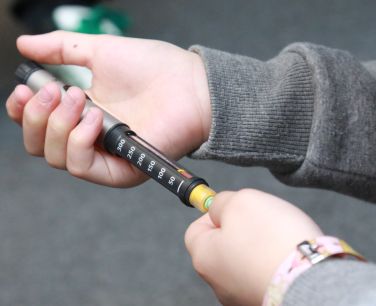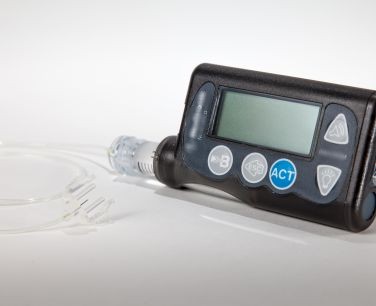The main goals of treating diabetes are:
- To keep blood glucose level within a target range
- To maintain balanced physical, mental, emotional and social growth and development.
The key to good diabetes management is a balance between food, exercise and insulin. It can be a bit of a juggling act, to manage the three aspects in order to keep blood glucose levels within a healthy range. Children with diabetes must follow a schedule for blood measuring, insulin injection, and meals to maintain a good balance. Any slight change from a child’s diabetes care plan can cause blood glucose levels to rise or fall.
Insulin
Treating diabetes means replacing the insulin that the pancreas doesn’t make and monitoring your child’s blood glucose levels. It’s important that the right insulin and delivery method is used to suit your child. Always consult your healthcare team before making changes to your child’s treatment regime.
Treatment for Type 1 diabetes
Type 1 diabetes is treated by insulin injections or pump infusion, a healthy diet and regular physical activities. Insulin cannot be taken in a tablet form because the acids and digestive juices in the stomach can break down and destroy the insulin if swallowed. Most children with Type 1 diabetes require three to four injections of insulin every day. These injections are vital and must be taken every day as part of the treatment plan. Be careful not to inject too much insulin, otherwise this could result in hypoglycaemia.
Insulin delivery methods
Syringes, insulin pens, and insulin pumps are three different delivery devices to administer insulin to people with Type 1 diabetes, whose body can’t produce insulin on its own.
Insulin injections

As part of the daily regimen for Type 1 diabetes, insulin must be injected three to four times a day using either syringes or insulin pens. When only one kind of insulin is needed, some may find insulin pens to be more convenient and comfortable. The exact number of injections and dosage is individualised and tailored to the child’s specific needs. For most of the time during the day, insulin injections are regularly scheduled. Children may start to do the injection themselves but their starting age may vary, depending on when they feel ready.
Insulin pumps

Insulin pump is an alternative to injection. A computerised device stores the insulin and flows through a cannula. The physical appearance is just like a pager connected to a flexible plastic tube with a needle inserted into the skin. The pump is often worn on a belt or in a pocket, and the cannula is taped in place with the needle removed. Insulin pumps continuously deliver a low (basal) doses of insulin. Common insertion sites on the body include the thighs, buttocks, upper arms and other areas with fatty tissue. Some insulin pump users use the bolus insulin method where extra amounts of insulin are delivered at meal times. This is effective for obtaining a tight control of the glucose level.
Advantages include:
• Greater flexibility with meals, exercise and daily schedule
• Improved physical and psychological well-being
• Better control of blood glucose levels.
Disadvantages include:
• Risk of infection
• Hypoglycaemia (low blood sugars) occurs more frequently
• Ketosis and ketoacidosis (risk of very high blood sugars)
• Constant physical reminder of diabetes.
If you are interested in finding out more about the insulin pump, please contact YDA.
Personal choice
Choosing the way for insulin injection is totally a personal decision for your child, family and doctor. The same method may not be the right choice for everyone.
Treatments for Type 2 diabetes
In many cases, adopting a healthier and active lifestyle can control Type 2 diabetes, however if that is not possible then insulin intake is required. A healthy diet is essential to limit and control blood glucose especially in the early stage of the disease’s progression. It is important to keep weight under control especially for children suffering from Type 2 diabetes.
Tablets and medication
If your child has Type 2 diabetes they may need medication to help manage their blood sugar levels. Some medication stimulates the pancreas to produce insulin, whereas others may be prescribed to help lose weight, if necessary.
If your child need to take tablets to manage their diabetes, you and your doctor will decide which is best for your child.
Diet and exercise
Lots of people with Type 2 diabetes don’t take any medication, and instead they treat their diabetes by eating well and being more active.
Get advice from your doctor on how to manage and check blood glucose, and tips on what to expect during the treatment.





